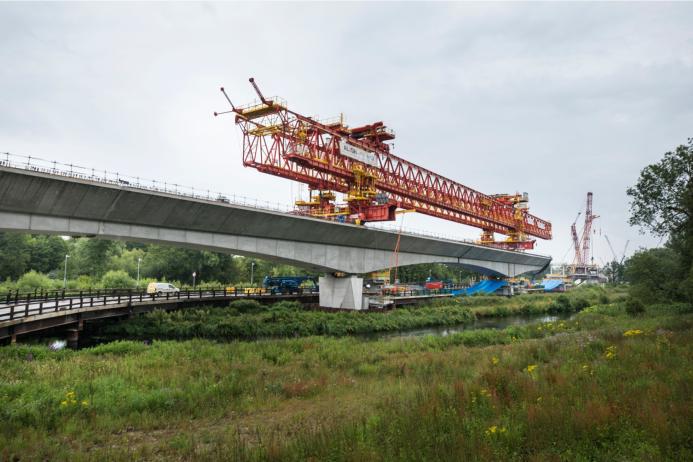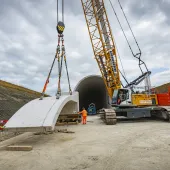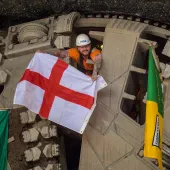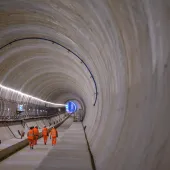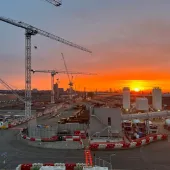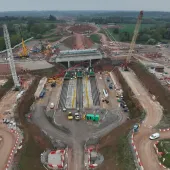Last of 56 piers built on HS2’s longest viaduct (video)
Construction of all the supporting piers of HS2’s viaduct across the Colne Valley has been completed after more than two years of work over land and water.
The deck segment cast on-site for the most southerly v-shaped pier over the Harefield Lake, completes the final pier for the viaduct.
The v-piers form the arch of the deck over the lakes with a range of vertical, fixed buttress and expansion buttress piers over the land and will support the viaduct’s deck for 2.1 miles across the Colne Valley.
Over 43 tonnes of concrete were poured into the formwork containing high-strength reinforcement steel and carefully set out post-tensioning ducts, to complete the final deck segment on the v-pier.
With the formwork now removed the complete final pier is revealed.
Using a giant launching girder to install the viaduct’s remaining 1000 deck segments pre-cast in a factory on-site, requires piers to be built in advance, ready for the girder to move onto as it makes its way from north to south across the Colne Valley.
The viaduct construction is being led by HS2’s main works contractor Align JV, which includes Bouygues Travaux Publics, Sir Robert McAlpine, and Volker Fitzpatrick.

Viaduct construction
Construction of the UK’s longest railway bridge began in early 2021, with a team of ground engineers sinking the first of almost 300 piles that form the foundations for the Colne Valley Viaduct.
In Spring 2022, an enormous 700-tonne bridge-building machine was launched on site. Known as a ‘launching girder’, the 160m-long bridge-building machine is the only one of its kind in the UK and will be used to lift the giant concrete deck segments that form the viaduct’s arches into position.
As each section was completed, the machine inched itself forward into position to build the next stage.
A total of one thousand deck segments were needed, with each one weighing up to 140 tonnes. To allow for the gentle curves of the viaduct as it crosses the valley, all the segments are slightly different shapes and made on site at a purpose-built temporary factory close to the north abutment.
Originally built in 2004, the launching girder was first used during the construction of the Hong Kong East Tsing Yi Viaduct. Specially designed to handle complex viaduct construction, the machine is named ‘Dominique’ in memory of Bouygues engineer Dominique Droniou who played a leading role in its design and development.
A total of 56 piers each weighing around 370 tonnes were constructed along the Colne Valley ahead of the girder, with the girder moving from one pier to the next, installing the deck segments as it goes.
One segment was put in place on each side of the central pier, using a cantilever approach to balance the structure, as two half-arches on either side of each pier were constructed simultaneously. Steel tensioning cables were then threaded through the segments to strengthen the bridge.
Every segment has a slightly different shape depending on where it fits into the viaduct and the modular approach was chosen to ensure quality, safety, and efficiency.
The viaduct pre-cast factory where the segments were made cast around 12 segments every week using a ‘match-casting’ technique. This approach – where each segment is poured against the previous one – ensured the whole deck fitted perfectly when assembled on the piers. The mammoth 100m long viaduct precast factory, which is visible from the M25, has an internal volume of 105,000 cubic metres – making it larger than the Royal Albert Hall.

